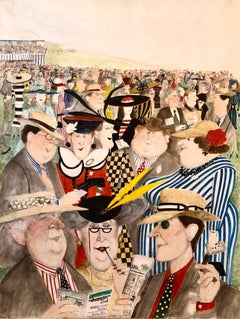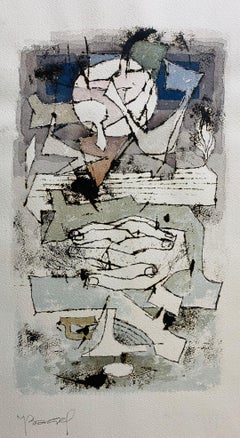Lions Gallery Drawings and Watercolor Paintings
1980s Modern Figurative Drawings and Watercolors
Watercolor
20th Century Modern Figurative Drawings and Watercolors
Ink, Watercolor, ABS
20th Century Modern Figurative Drawings and Watercolors
Ink, Watercolor, ABS
20th Century Modern Figurative Drawings and Watercolors
Ink, Watercolor, ABS
20th Century Modern Figurative Drawings and Watercolors
Ink, Watercolor, ABS
20th Century Modern Figurative Drawings and Watercolors
Ink, Watercolor, ABS
20th Century Modern Figurative Drawings and Watercolors
Ink, Watercolor, ABS
20th Century Modern Figurative Drawings and Watercolors
Ink, Watercolor, ABS
Mid-20th Century Expressionist Drawings and Watercolor Paintings
Lithograph
Mid-20th Century Expressionist Drawings and Watercolor Paintings
Lithograph
Mid-20th Century Expressionist Drawings and Watercolor Paintings
Lithograph
Mid-20th Century Expressionist Drawings and Watercolor Paintings
Lithograph
Early 20th Century Post-Impressionist Drawings and Watercolor Paintings
Etching
Early 20th Century Post-Impressionist Drawings and Watercolor Paintings
Etching
Early 20th Century Post-Impressionist Drawings and Watercolor Paintings
Etching
Early 20th Century Post-Impressionist Drawings and Watercolor Paintings
Etching
Early 20th Century Post-Impressionist Drawings and Watercolor Paintings
Etching
Early 20th Century Post-Impressionist Drawings and Watercolor Paintings
Etching
Early 20th Century Post-Impressionist Drawings and Watercolor Paintings
Etching
Early 20th Century Post-Impressionist Drawings and Watercolor Paintings
Etching
Early 20th Century Post-Impressionist Drawings and Watercolor Paintings
Etching
Early 20th Century Post-Impressionist Drawings and Watercolor Paintings
Etching
20th Century Modern Drawings and Watercolor Paintings
Ink, Watercolor, ABS
Early 20th Century Impressionist Drawings and Watercolor Paintings
Etching
Late 20th Century Abstract Figurative Drawings and Watercolors
Ink, Pen
1970s Surrealist Figurative Drawings and Watercolors
Ink, Watercolor
20th Century Modern Figurative Prints
Mixed Media, Watercolor
1980s Surrealist Figurative Paintings
Paper, India Ink, Watercolor
1980s Surrealist Figurative Paintings
Paper, India Ink, Watercolor
Late 20th Century Surrealist Figurative Paintings
Paper, India Ink, Watercolor
20th Century Modern Landscape Drawings and Watercolors
Watercolor, Lithograph
20th Century Modern Landscape Drawings and Watercolors
Watercolor, Lithograph
20th Century Modern Landscape Drawings and Watercolors
Watercolor, Lithograph
1970s Surrealist Figurative Drawings and Watercolors
Ink, Watercolor
1990s Abstract Still-life Drawings and Watercolors
Color Pencil
Mid-20th Century Pop Art Figurative Drawings and Watercolors
Mixed Media
Mid-20th Century Pop Art Figurative Drawings and Watercolors
Mixed Media
Mid-20th Century Pop Art Figurative Drawings and Watercolors
Mixed Media
Mid-20th Century Pop Art Figurative Drawings and Watercolors
Mixed Media
Mid-20th Century Pop Art Figurative Drawings and Watercolors
Mixed Media
Mid-20th Century Modern Still-life Drawings and Watercolors
Archival Ink, Watercolor
1940s Modern Figurative Drawings and Watercolors
Watercolor
20th Century Modern Figurative Drawings and Watercolors
Watercolor
20th Century Modern Figurative Drawings and Watercolors
Watercolor
Mid-20th Century Abstract Abstract Drawings and Watercolors
Crayon, Oil Pastel
Mid-20th Century Abstract Expressionist Abstract Drawings and Watercolors
Crayon, Pastel
Mid-20th Century Abstract Abstract Drawings and Watercolors
Crayon, Pastel
Mid-20th Century Expressionist Abstract Drawings and Watercolors
Ink, Watercolor
Mid-20th Century Expressionist Landscape Drawings and Watercolors
Pastel, Ink, Watercolor
1960s Pop Art Landscape Drawings and Watercolors
Paper, Ink
20th Century Modern Figurative Drawings and Watercolors
Watercolor, Lithograph
20th Century Modern Figurative Drawings and Watercolors
Watercolor, Lithograph
20th Century Modern Figurative Drawings and Watercolors
Watercolor, Lithograph
20th Century Modern Figurative Drawings and Watercolors
Watercolor, Lithograph
20th Century Modern Figurative Drawings and Watercolors
Watercolor, Lithograph
1970s Modern Figurative Drawings and Watercolors
Watercolor, Lithograph
20th Century Modern Figurative Drawings and Watercolors
Watercolor, Lithograph
1970s Modern Figurative Drawings and Watercolors
Watercolor, Lithograph
20th Century Modern Figurative Drawings and Watercolors
Watercolor, Lithograph
1970s Modern Landscape Drawings and Watercolors
Lithograph





